| |
WINSTON CHURCHILL REFERED TO THE U.S. AS "OUR ROMANS," WHO WOULD
DO
THE HEAVY LIFTING, WHILE THE BRITISH EMPIRE (LEOPARD) PROVIDED THE
"BRAINPOWER" AND THE SPYING SKILLS!!
|
|
The entry of the U.S.
into World War II as an "ally" of Britain was an unmitigated disaster
for mankind. It led to the creation of the UN, NATO, and NSA, the creation
of the Edomite state of "Israel," and other wars and disasters that have plagued
the world since 1941.
The Phony War or sitzkrieg
between Britain and Germany began on September 1, 1939, when the Third Reich invaded Poland. 2 days later Britain and France declared war on Germany .
. . but both countries did nothing to help Poland....Britain began
to transfer a vast amount of military equipment to France which she hoped
"Uncle Sap" would replace with Lend-Lease.
On May 10, 1940, Hitler
invaded France and conquered that country with a lighting attack called blitzkrieg.
The British Expeditionary Force evacuated at Dunkirk leaving a huge
amount of armaments behind for their spy Adolf Hitler to use in the invasion
of Russia.
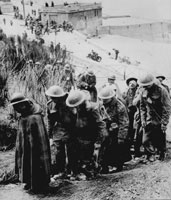
British
evacuation at Dunkirk.
|
|
The
British Expeditionary Force began evacuating from Dunkirk in June
1940.
Winston
Churchill left a huge amount of armaments behind for his Third Reich.
A
grateful Führer(amazed at the speed of the victory) visited the
Eiffel Tower on June 23, 1940.
|
|
|
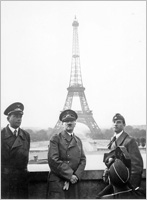
Hitler doppelganger in front of
the Eiffel Tower.
|
The 3 Führers thanked
Churchill for the 40,000 vehicles, as well as massive amounts of other military
equipment, left behind for his planned invasion of Russia.
With the industrial
output of France at his disposal, theFührers felt supremely confident of a blitzkrieg
victory over the Soviet Union.
Churchill's
Operation Fish turned Uncle Sam into "Uncle SAP"
The operation to turn
Uncle Sam into "Uncle Sap" required vast quantities of real money–gold....Politicians,
generals, editors, movie producers, actors, spies etc., etc., would not
offer their services to the British Empire for free . . . so a massive transfer
of gold from the Bank of England to the Bank of Canada took place in 1940.
The British gold hoard
was stolen from the Boers of South Africa and
stored in vast underground vaults in London. A huge quantitly of the gold
was used to finance Hitler's Third Reich; and the remainder was loaded on
ships, and all the gold arrived safely in Canada . . . despite the menace
of the Nazi U-boats!!
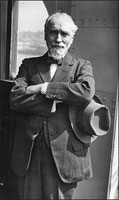
Montagu Norman
(1871–1950).
|
|
Immediately
after becoming prime minister in May 1940, Winston Churchill
ordered the transfer of all Britain's gold bullion and securities
to Canada.
Churchill
called it Operation Fish!!
The
ostensible reason was to keep it out of the hands of Hitler,
in reality, the gold was used to bribe the U.S. into
becoming an "ally" against his Third Reich. |
|
|
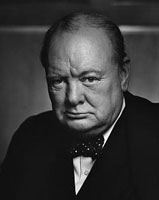
Winston Churchill (18741–1965).
Misruled from 1914 to 1965.
|
The governor of the
Bank of England, Montagu Collet Norman, and the chancellor of the exchequer,
Sir Howard Kingsley Wood, worked closely with Churchill in the top secret
transfer of the greatest combined load of treasure ever transported by land
or sea.
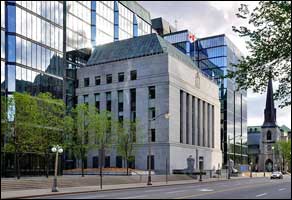
The Bank of Canada in Ottawa, Ontario.
|
|
The
gold bullion was placed in the Bank of Canada.
The
securities ended up in the Sun Life Building in Montreal.
During
the Civil War, British
gold arrived in Canada to destroy the Union.
In
1940, gold arrived to make an "ally" of the United
States!! |
|
|

The Sun Life Building
in Montreal.
|
The conveys
were commanded by Admiral Ernest Russell Archer, and miracle of miracles,
not one ship was fired upon by the prowling Nazi U-boats:
When
the unprecedented project was completed, the Admiralty determined that gold
worth more than $2.5 billion had been shipped to Canada. Astoundingly, during
the three months when 134 Allied and neutral ships had been sent to the
bottom by German action in the North Atlantic, not one treasure-carrying
vessel was sunk or even attacked.
An even more astonishing aspect of Fish, however, was that as many as 1,000
persons on both sides of the Atlantic were involved in the transfer of Great
Britain's treasure–and the secret was kept from Adolf Hitler. (Breuer,
Top Secret Tales of World War II, p. 62).
Little
did the Mothers Against Intervention realize that their opponents were on
the British payroll.
The
U.S. "Fight for Freedom" MI6 front!
Churchill and Hitler's
timing could not have been better because 1940 was a Presidential election
year in the U.S., and FDR had decided to run for an unprecedented 3rd term
as President.
In July, a bunch of
British spies formed an organization called the Century Group which was
dedicated to getting the U.S. fighting with the British against Hitler:
At 7:30
on Friday, July 11, 1940, Lewis W. Douglas, President of Mutual Life Insurance
Company and former Director of the Budget, gave a dinner for eleven friends
and acquaintances at New York's Columbia Club. Five of his guests-Herbert
Agar, Bishop Henry Hobson, Francis Miller, Whitney Shepardson, and Admiral
William Standley-had signed "A Summons to Speak Out." All who
were present shared the belief that the European war was in fact America's
war. Since Dunkirk and the fall of France, each had concluded privately
that sooner or later American armed intervention would be necessary to prevent
world domination by Hitler. Most felt that the United States should declare
war immediately to prevent the fall of Great Britain and the surrender to
the Nazis of "America's first line of defense"–the British
Fleet. But they also knew that what they believed to be America's national
interest was certainly not its national desire; that the overwhelming majority
of Americans, though sympathetic to the British, wanted no return to the
machine guns, mud, and gas of Chateau-Thierry and the Argonne Forest and
no repetition of the "betrayal" of Versailles. These dozen men
were dedicated to changing America's mind. (Chadwin, The Hawks of World
War II, p. 43).
The Century Group was
just part of an extensive MI6 spy ring called British Security Coordination
or BSC for short. Here are just 2 members of the spy ring whose newspaper
columns reached millions of readers.
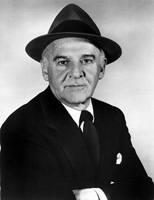
Walter Winchell
(1897–1972). |
| |
Walter
Winchell was a syndicated columnist with a vast readership who
was really a front man for BSC.
Walter
Lippman was another syndicated columnist with ties to BSC.
Both
men were determined to get the U.S. involved in WWII. |
|
|

Walter Lippman
(1889–1974).
|
Winchell's newspaper column
was syndicated in over 2,000 newspapers worldwide, and he was read by 50 million
people a day from the 1920s until the early 1960s. His Sunday-night radio
broadcast was heard by another 20 million people from 1930 to the late 1950s.
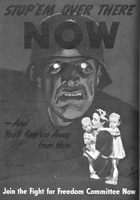
Crude BSC anti-German propaganda flyer.
|
|
No
avenue of propaganda was overlooked. Flyers were handed out at
baseball games saying that "Heel' Hitler and his Berlin
Bullies would outlaw baseball if they conquered the world.
They
did not mention that Hitler would replace baseball with cricket!
Little
did the people realize that Churchill had 3 HItlers. |
|
|
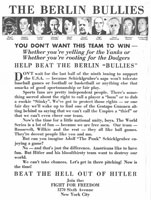
Help defeat the Berlin Bullies flyer.
|
Of course
"Snoops" Himmler would spy on everyone if Hitler won. The Berlin
Bullies who were out to conquer the world included "Fats" Goering,
"Spider" Goebbels, "Rats" Ribbentrop, etc., etc.
Mothers
Against intervention countered the crude British propaganda!
The American
people, especially mothers, were not going to be fooled into another war in
Europe by British spies and their crude propaganda. They mobilized in a huge
patriotic effort and let Congress know in no uncertain terms that they would
not condone another war:
A loose national coalition
of right-wing women's groups, with names like the Congress of American Mothers
and the American Mothers' Neutrality League, added to the furor. Thousands
of supporters of this so-called "mothers' movement" traveled to
Washington whenever Congress took up legislation they considered interventionalist.
Dressed in black, many with veils covering their faces, the women made life
miserable for members of Congress who were not avowedly isolationist. They
stalked their targets, screamed and spat at them, and held vigils outside
their offices, keening and wailing. (Olsen, Those Angry Days, p.
213).
CONfederate Senator Claude
Pepper from Florida was a rabid interventionalist.
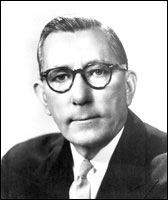
Senator Claude Pepper
(1900–1989).
|
|
CONfederate
Senator Claude Pepper from Florida was the leading proponent of
intervention in the Senate.
Mothers
Against Intervention called this CONfederate "Benedict Arnold"
Pepper and hung him in effigy outsize the Capitol.
It
was their finest hour!!
|
|
|
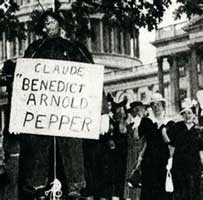
Mothers Against Intervention hung an effigy
of Claude Pepper outside
the Capitol.
|
In the United
States, to call a person a "Benedict Arnold" is to refer to him/her
as the worst kind of traitor . . . but general Benedict Arnold was
a patriot compared to Claude Pepper . . . because general Benedict
Arnold almost succeeded in driving the British out of Canada!!
The U.S.
mothers were joined by a plethora of prominent patriots who joined the fight
against intervention. 2 of the most prominent were Charles Lindbergh and Hamilton
Fish.

Charles Lindbergh speaking
at an America First Rally.
|
| |
"Lone
Eagle" Charles Lindbergh used his great influence to keep
his country out of war.
New
York Congressman Hamilton Fish fought a successful battle against
the British interventionalists.
Both
men were called Nazi appeasers, "Heel" Hitler lovers,
unpatriotic etc., etc., by the BSC controlled press.
|
|
|
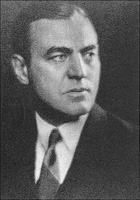
Congressman Hamilton Fish
(1888–1991).
|
The number
of patriotic people who favored non-intervention were legion. 2 of the most
prominent were Senator Burton Wheeler of Montana and Senator Gerald P. Nye
of North Dakota.
In desperation,
Churchill ordered Hitler to bomb Britain!
So effective
were the Mothers Against Intervention, and other patriotic groups, that FDR
was afraid to declare war on Germany. Churchill's spies and propaganda experts
had failed to change public opinion.
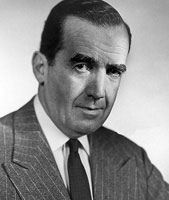
Edward R. Morrow
(1908–1965).
|
|
On
September 7, 1940, Nazi bombers began to bomb London and other
cities in England.
Edward
R. Morrow began a nightly radio broadcast to the U.S. called
"This
is London."
Nobody
knew at that time that Morrow was an MI666 agent!!
|
|
|
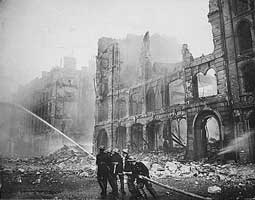
London during the Blitz.
|
Morrow's
nightly broadcasts from London electrified his huge audience in the United
States. As well as Morrow's broadcasts, doctored photos were planted in newspapers
about the horrors of the bombing.
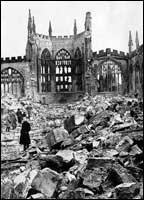
Bombed Coventry Cathedral.
|
|
Churchill
and the Führers chose bombing targets in England for their maximum
propaganda value in the U.S.
Doctored
or fake photos of bombing "victims" using mannequins
or dummies were shown in the U.S.
These
obvious fakes were not shown in British newspapers.
|
|
|
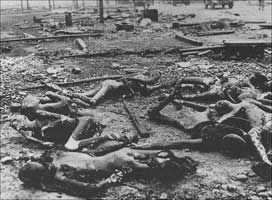
Fake or doctored bombing "victim" photos
were shown in the
U.S. |
The Blitz
was powerful propaganda indeed but it did not lead to a declaration of war
on Germany. What it did lead to was the first peacetime military draft or
conscription in the nation's history.
The Selective
Service and Training Act of 1940, also known as the Burke-Wadsworth Act, was
enacted on September 16, 1940. It was the first peacetime conscription in
United States history. The Selective Service Act required that men between
the ages of 21 and 35 register with local draft boards. Later, when the U.S.
entered World War II, all men aged 18 to 45 were made subject to military
service, and all men aged 18 to 65 were required to register.
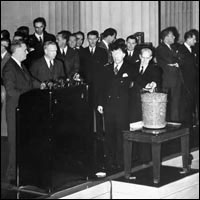
Henry L. Stimson drawing the
first names for the draft lottery.
|
|
Thanks
to the Berlin Bullies and the Blitz, FDR signed the first
peacetime military draft in U.S. history.
Inductees
were required to serve for 12 months.
Thanks
to "Heel" Hitler, and a front man named Wendell Willkie,
FDR was elected for an unprededented 3rd term in 1940.
|
|
|
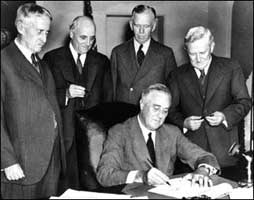
FDR signed the Selective Service
and Training Act on Sept. 16, 1940.
|
Sinister
British spy Grenville Clark was the driving force behind the first peacetime
draft.
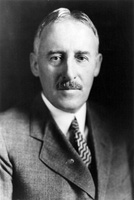
Henry L. Stimson (1867–1950).
Sec. of War from '41 to '45).
|
|
Sinister
British spy Grenville Clark was the driving force behind the first
peacetime draft.
Clark
was assisted by FDR's bellicose Secretary of War Henry L. Stimson
and general George C. Marshall in civilian clothes.
|
|
|

Grenville Clark (1882–1967) was
the driving force behind the draft.
|
The British ambassador
to the U.S. at that time was named Philip Kerr or Lord Lothian. Lord Lothian
was disgusted with the underhanded tactics of his own spies, so he had a timely
death in December 1940.
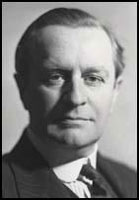 Lord Lothian (1882–1940)
had
Lord Lothian (1882–1940)
had
a timely demise in Dec. 1940. |
| |
Lord
Lothian was the British ambassador to the U.S. in 1940.
He
loathed the underhanded methods of his own spies; he did
not pursue intervention aggressively enough, and so he had a timely
demise in December 1940.
Lord
Halifax, a more compliant personage, took his place as
ambassador.
|
|
|
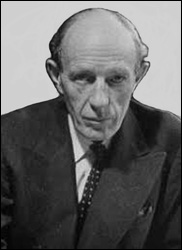 Lord Halifax
Lord Halifax
(1881–1959). |
Patriotic people who opposed
intervention had "car accidents," committed "suicide,"
or had their reputations completely destroyed!!
In desperation,
Churchill ordered Japan to bomb Pearl Harbor!
Not even the gold from
the Bank of Canada; the bombing of London, and other cities in England, could
convince the non-interventionalists that the U.S. should declare war on Germany.
The first peacetime draft
was due to expire in November 1941, and still the U.S. was not involved in
the war. Churchill was growing desperate. His last card to play was his ally
Japan. Japan was a signatory to the Tripartite Pact or Axis Pact of Nazi Germany,
Fascist Italy, and Imperial Japan. Japan's role in the Pact was to attack
Russia from the East while Germany attacked from the West.
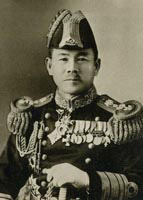
Admiral Toyoda
(1885–1961).
|
|
Admirals
Yamamoto and Toyoda were the MI6 boots on the ships in
Tokyo.
Japan
was supposed to attack Russia in the rear but Churchill ordered
a drastic change in plans.
The
Japanese naval code called Purple was already broken and all their
communications were read by the U.S. and Britain.
|
|
|
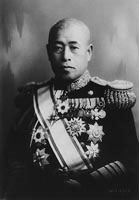
Admiral Yamamoto
(1884–1943).
|
A brilliant team of cryptographers
under William F. Friedman worked on the top secret Japanese naval code for
years and the code was finally broken in 1940. They called it Purple
but the CONfederate Navy called it Magic.
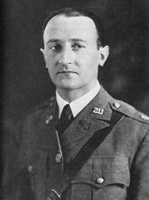
Major William F. Friedman
(1891–1969).
|
|
Major
William F. Friedman headed the group of cryptographers that broke
the Japanese naval code.
Frank
B. Rowlett did the actual breaking of the code but Friedman later
claimed credit for the groundbreaking deciphering.
From
1940 onward, the Japanese navy had no more secrets.
|
|
|
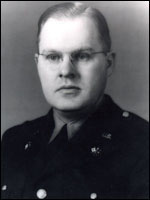
Frank B. Rowlett
(1908–1998).
|
Without ever seeing a
Japanese encryption machine, Rowlett constructed one from sheer guesswork,
and it bore an uncanny resemblance to the Japanese original.
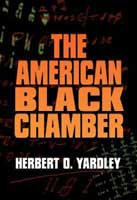
Yardley's tell-all book was
published in 1931. |
| |
Just before
the "surprise attack," the Father of U.S. cryptography
was working for the Canadian government.
In
1920, Herbert O. Yardley broke the Japanese code, but in 1929
he was fired by Secretary of State Henry L. Stimson because he
broke the Vatican's diplomatic code.
In
May 1941, the Canadian government hired Yardley to set up their
own cryptographic bureau. |
|
|
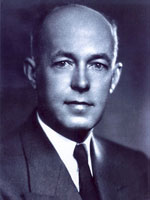
Herbert O. Yardley
(1886–1958). |
Yardley soon had the Canadians
listening in on German, Japanese, and Vichy French coded transmissions. Just
days before Pearl Harbor, Churchill ordered the Canadian government to fire
Yardley . . . because he knew too much:
On Saturday December 6, 1941, Yardley made one final bid to
save the job he loved. He sent a lengthy memo to Stone asking that the arrival
of his replacement from Britain be delayed thirty days to give him a chance
to defend himself. He enclosed a copy of a personal appeal made on his behalf
to the President's wife, Eleanor Roosevelt.
There was no reprieve. The British had ruled that Yardley had to be out of
town before the new man arrived. Yardley's contract had only two more days
to run. Though it was a few more weeks before he actually cleared the city,
it was effectively his last day on the job. (Bryden, Best-Kept
Secret: Canadian Intelligence in the Second World War, p.
89).
The firing of Yardley
meant that the truth about the "surprise attack" would be covered
up, and the Canadians were prevented from developing their own signals intelligence
independent of the British. Only hours after the "surprise attack"
Canada declared war on Japan.
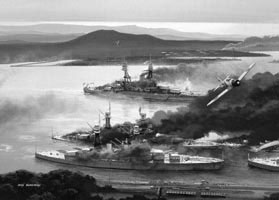
Burning battleships at Pearl Harbor.
|
|
The
"surprise attack" to overcome the Mothers Against Intervention
was the work of the CONfederate navy, the Royal navy, and the
Japanese navy.
Admiral
Yamamoto was overall commander of the Japanese Combined Fleet
during the "surprise attack."
|
|
|
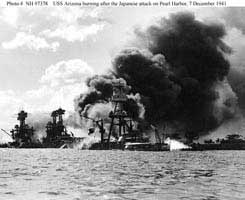
Destruction of
the Arizona at
Pearl Harbor.
|
Admiral Yamamoto was singled
out for execution . . . not because he was a competent admiral . . . but because
he was the "fall guy" and he knew too much.
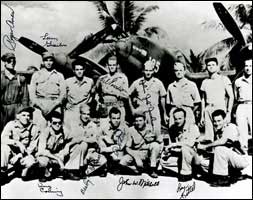
Pilots who shot down
Admiral Yamamoto in 1943.
|
|
On
April 18, 1943, Admiral Yamamoto was ambushed and shot down by
16 fighter aircraft.
Thanks
to Purple, the admiral's itinerary was well known in advance.
|
|
|
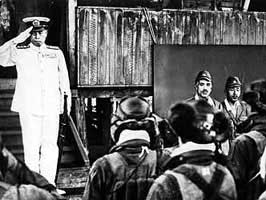
Admiral Yamamoto just days before
he was shot down.
|
The Admiral was not shot
down as a revenge attack for Pearl Harbor, but he had misgivings
about the war, and he was about to reveal the identity of the people behind
the "surprise attack."
The attack
on Pearl Harbor took the pressure off the Russians!
Just as the "surprise"
attack on Pearl Harbor took place, the Wehrmacht was launching a major offensive
to capture Moscow. Stalin's secret agent in Tokyo was named Richard Sorge
and he kept Moscow informed of the impending attack southward.
Sorge's cover was "reporter"
for the German language Frankfurter Zeitung but every chance he got
he told the Japanese hierarchy that an attack on Russia would be suicidal.
Japan was just waiting
for an opportune moment to attack Russia in the rear while Hitler was invading
from the West.
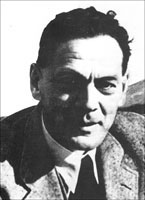
Russian agent Richard Sorge
(1895–1944).
|
|
As
a "reporter" for the Frankfurter Zeitung, Sorge
subtly warned the Japanese that an attack on Russia would be fatal.
When
he found out for sure that the Japanese would attack the U.S.,
he notified Stalin, who began to move his Siberian divisions to
Moscow.
Sorge's
"reward" was later betrayal by Stalin and a hangman's
noose in a Japanese jail.
|
|
|

Richard Sorge was accepted everywhere, even at the Emperor's Palace.
|
With the Japanese at war
with the United States, Stalin was able to move 18 divisions, 1,700 tanks,
and over 1,500 aircraft from Siberia to the defense of Moscow.
Richard Sorge was a "good
spy" who saved western civilization from Fascism and Nazism.
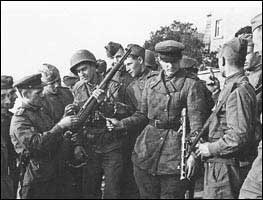
A U.S. soldier demonstrates the use of the M-1 rifle to his curious
Red Army comrades. |
| |
The
G.I.'s were amazed that the Russian soldiers did not wear helmets.
The
Russians explained that helmets were for "sissies,"
they were a hindrance in offensive combat, and they did not care
about casualties as long as they were victorious in the end!! |
|
|
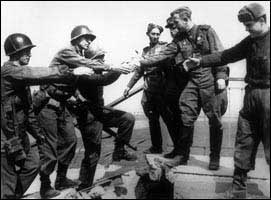
U.S. and Russian soldiers
meeting at the Elbe River. |
At that point in time
the millennium would have truly arrived if all monarchies were abolished
and the U.S. and Russia united in peace and friendship to police the world.
Uncle Sam became "Uncle
Sap" again with the UKUSA Agreement!
In 1947, Uncle Sam became
"Uncle Sap" again when he entered into a top secret spying
agreement with his deadly enemy–Churchill and the British Empire.
This agreement, called
the UKUSA Agreement or Five Eyes, pooled the spying resources of the United
States, UK, Canada, Australia and New Zealand....This type of spying called
signals intelligence (SIGINT) made James Bond obsolete.
The agreement established an alliance
of five English-speaking countries for the purpose of sharing intelligence,
especially signals intelligence. It formalized the intelligence sharing agreement
in the Atlantic Charter, signed in 1941, before the entry of the U.S. into
the conflict. Here is a report on that agreement from Wikipedia:
The United
Kingdom – United States of America Agreement is a multilateral agreement for
cooperation in signals intelligence among the United Kingdom, the United States,
Canada, Australia, and New Zealand. The alliance of intelligence operations
is also known as Five Eyes. It was first signed in March 1946 by the United
Kingdom and the United States and later extended to encompass the three Commonwealth
realms of Canada, Australia and New Zealand. The UKUSA Agreement was a follow-up
of the 1943 BRUSA Agreement, the World War II agreement on cooperation over
intelligence matters. This was a secret treaty, allegedly so secret that it
was kept secret from the Australian Prime Ministers until 1973. (UKUSA
Agreement).
This agreement with death
and hell led to the creation of NSA in 1952.
The birth of the top
secret National Security Agency or NSA (Never
Say Anything) took
place on Election Day, November 4, 1952.
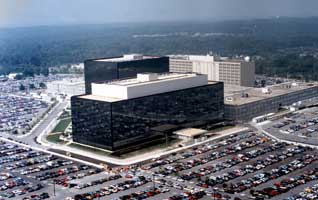
Massive CONfederate
NSA spying HQ
in Fort Meade, Maryland.
|
|
The
1946 UKUSA Agreement was a marriage
made in HELL.
British
expertise at tapping undersea cables was married to CONfederate
spying satellites to create an Orwellian "big brother"
spying machine that is truly catholic and universal. |
|
|
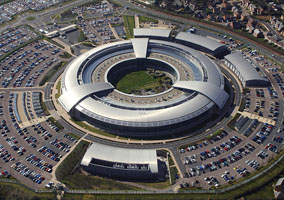
Massive British spying hdqrs. (GCHQ)
in Cheltenham, Gloucestershire. |
With the savings realized
from the Walt Disney Studios moon landing, CONfederate and British spymasters
used the money to launch a whole series of spy satellites to augment the vast
amount of data obtained from tapping undersea cables.
Here is what the Holy
Bible predicts will soon happen to this spying covenant with death and hell
called the UKUSA Agreement:
And your
covenant with death shall be disannulled, and your agreement
with hell shall not stand; when the overflowing scourge shall pass through,
then ye shall be trodden down by it (Isaiah 28:17-19).
References
Bamford,
James.
The Puzzle Palace: A Report on America's Most Secret Agency.
Houghton Mifflin Co., Boston, 1982.
Bryden,
John. Best-Kept
Secret: Canadian Intelligence in the Second World War.
Lester Publishing Co., Toronto, Ontario, 1993.
Breur,
William B. Top Secret Tales of World War II. John Wiley &
Sons, New York, 2000.
Conant,
Jennet. The
Irregulars: Roald Dahl and the British Spy Ring in Wartime Washington.
Simon & Schuster, New York, 2008.
Chadwin,
Mark Lincoln. The Hawks of World War II. University of North
Carolina Press, Chapel Hill, 1968.
Cull,
Nicholas John. Selling
War: The British Propaganda War Against American Neutrality in WWII.
Oxford University Press, New York, 1995.
Draper,
Alfred, Operation Fish. Don Mills, Ontario, Canada, 1979.
Dobbs,
Michael, Six Months in 1945: FDR, Stalin, Churchill, and Truman-From
World War to Cold War. Alfred A. Knopf, New York, 2012.
Kahn,
David, The Codebreakers: The Story of Secret Writing. Scribner,
New York, 1996.
Olsen,
Lynne. Those
Angry Days: Roosevelt, Lindbergh, and America's Fight over WWII,
Random House, New York, 2013.
Fish,
Hamilton, Memoir of an American Patriot. Regnery Gateway, Washinton
City, 1991.
Mahl,
Thomas E. Desperate
Deception: British Covert Operation in the United States, 1939–44.
Brassey's, Washington City, 1998.
Rowlett,
Frank B. The Story of Magic: Memoirs of an American Cryptologic
Pioneer. Aegean Park Press. Laguna Hills, CA, 1998.
Stinnett,
Robert B. Day
of Deceit: The Truth About FDR and Pearl Harbor.
The Free Press, New York, 2000.
Whymant,
Robert. Stalin's Spy: Richard Sorge and the Tokyo Espionage Ring.
St. Martin's Press, New York, 1996.
Winterbotham,
F.W. The
Nazi Connection. Harper & Row, New York & London, 1978.
Yardley,
Herbert O. The
American Black Chamber. Naval Institute Press, Annapolis, Maryland.







































